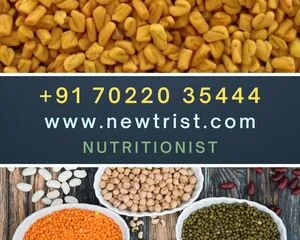The Coeliac disease diet plan consists of fruits, vegetables, whole grains, beans, legumes, meat, poultry, seafood, dairy products, nuts, and seeds.
- Early morning drink @ 6:30 am: Orange juice
- Breakfast @ 9 am: Beetroot dosa with green chutney
- Mid-morning meal @ 11 am: Boiled egg/Fresh fruits
- Lunch @ 1 pm: Vegetable pulav with eggplant sabzi and cucumber raita
- Evening snack @ 4 pm: Roasted makhana
- Dinner @ 7 pm: Mixed vegetable-dal khichdi and turmeric milk at bedtime
Consult 19 years experienced Chief Nutritionist Vasanthi for expert advice and a personalized diet plan. In-person consultation at HSR, Koramangala, Bellandur, Haralur, and video consultation across India.
- Consultation INR 750
- 1 Week personalized diet plan INR 2000
- 1 Month personalized diet plan INR 4000
- 3 Months personalized diet plan INR 9000

Table of Contents
What is Coeliac disease?
Coeliac disease is an autoimmune disease that damages the lining of the small intestines. Coeliac disease may take a few months to heal for children but for adults, it may take several years. It mostly affects children over 2 years of age and adults of any age group. A healthy and nutritious diet is essential for the healing process and the prevention of the progression of the condition.
Even small amounts of gluten intake can cause an autoimmune response and damage your intestines in the absence of symptoms. This results in the malabsorption of nutrients from the small intestine and lead to digestive problems like diarrhea, unexplained weight loss, and malnutrition.
Diarrhea, fatigue, abdominal pain, headache, anemia, and indigestion are some of the symptoms of Coeliac disease. Almost 90% of people with coeliac disease have shown improvements in their symptoms by following a gluten-free diet.
Intestinal problems like diarrhea are the first symptom to resolve within a couple of days after starting the gluten-free diet. Children on a gluten-free diet for 2 years showed no signs of intestinal damage.
Malnutrition is common in children due to the poor absorption of nutrients in the small intestine. Deficiency of nutrients like calcium, iron, zinc, magnesium, folate, vitamin B12, riboflavin, niacin, and vitamins A, D, E, and K are also common.
Women with coeliac disease may experience infertility issues and face a greater risk of miscarriage. Untreated coeliac disease may lead to reduced bone density and an increased risk of osteoporosis. This is mainly due to the poor absorption of calcium and vitamin D.

What are the symptoms of Coeliac disease?
Symptoms of Coeliac disease are severe diarrhea, persistent GI discomforts, consistent stomach pain, anemia, tiredness, nausea, vomiting, and constipation. Some adults may experience symptoms unrelated to Coeliac disease such as reduced bone density, itchy skin, ulcers in the mouth, joint pain, and Hyposplenism. Excessive thirst, frequent urination, weakness, trembling, confusion, blurred vision, and weight loss are some of the additional symptoms observed in coeliac disease.
The hindrance in the absorption of nutrients in children may lead to weight loss, anemia, late puberty, damage of tooth enamel, and attention-deficit/hyperactivity Disorder (ADHD).
Consultation with the doctor is advised if diarrhea persists for more than 2 weeks. A doctor’s assistance is needed if the child grows a potbelly or if the stools are foul-smelling.
Think before trying a gluten-free diet before you are diagnosed with Coeliac disease. Coeliac disease may be hereditary or maybe the risk factor for type 1 diabetes.
Consistent intake of gluten-rich foods and certain genetic factors may contribute to coeliac disease, whereas, the primary cause of coeliac disease is unknown. GI infections, damage to gut bacteria, and some infant-feeding formulas may be some of the reasons for coeliac disease.
Small, hair-like projections called Villi in the small intestine aid in the absorption of vitamins, minerals, and other essential nutrients from food. When the gluten in the food causes damage to the villi, it reduces the availability of nutrients to the body.
What are the stages of Coeliac disease?
Coeliac disease is classified into 5 different stages, they are Stage 0 (Pre-infiltrative stage), Stage 1, Stage 2, Stage 3, and Stage 4.
What is stage 0 of coeliac disease?
Stage 0 of the pre-infiltrative stage is the beginning stage where the lymphocytes have not approached the intestinal lining.
What is stage 1 of coeliac disease?
During stage 1 Marsh score, the lymphocytes have found their way to the surface of the intestinal lining called the epithelial cells. The normal count of lymphocytes should not be more than 30 in healthy intestines, but in coeliac disease, it ranges above the normal levels. Increased lymphocytes in the small intestine promote inflammation and damage.
What is stage 2 of coeliac disease?
In stage 2, there appear large depressions between the villi of the small intestine known as “Crypts or Hyperplastic Crypts”. Stage 2 is most common among dermatitis herpetiformis.
What is stage 3 of coeliac disease?
Diagnosis is difficult until the coeliac disease reaches stage 3 which is further classified into
Partial villous atrophy (stage 3a)
Subtotal villous atrophy (stage 3b)
Total villous atrophy (stage 3c)
During Partial villous atrophy, the intestinal villi are smaller than healthy villi. In subtotal villous atrophy, the villi have shrunken in size significantly. In total villous atrophy, the intestinal lining appears flat with no villi.
What is stage 4 of coeliac disease?
Stage 4 is the advanced stage of the coeliac disease where the intestinal lining is flat with the shrinking of the depressions between the crypts. Stage 4 is mostly seen in older people with a high risk of lymphoma.
What are the types of Coeliac disease?
The 3 different types of Coeliac disease are Classical coeliac disease, Non-classical coeliac disease, and Silent coeliac disease.
What is classical coeliac disease?
In Classical coeliac disease, the patients experience diarrhea, steatorrhea, weight loss, and growth retardation in children.
What is non-classical coeliac disease?
In Non-classical coeliac disease, symptoms like mild gastrointestinal disorders, abdominal distention, and pain, anemia, chronic fatigue, chronic migraine, increased secretion of liver enzymes, tingling sensation in the hands and feet, decreased bone density, higher risk of fractures, deficiency of B vitamins, infertility issues, loss of tooth enamel, skin rashes, depression, and anxiety.
What is silent coeliac disease?
Silent coeliac disease is also called asymptomatic coeliac disease. As the name suggests, it is usually asymptomatic but still, there are some chances of villous atrophy damage to the small intestine. Even when the patients do not experience any symptoms, following a gluten-free diet improves the complaints of acid reflux, abdominal bloating, flatulence, and distension.
Coeliac Disease Diet Plan
Coeliac Disease Diet Plan should consist of gluten-free foods. Stay away from foods made with wheat, barley, rye, semolina, self-rising flour, and durum wheat.
- Early morning drink @ 6:30 am: Ginger tea with tulsi and honey
- Breakfast @ 9 am: Oatmeal with fruits and nuts
- Mid-morning meal @ 11 am: Amaranth-lentil soup
- Lunch @ 1 pm: Brown rice with methi dal and stir-fried cabbage and low-fat curd
- Evening snack @ 4 pm: Baked potato-corn fritters with herbal tea
- Dinner @ 7 pm: Finger-millet roti with coconut chutney
Weight loss is an indication of a gluten-free diet which is due to the cut down on refined carbohydrates and processed foods that contain gluten. A diet rich in fruits, vegetables, and whole grains helps in improving your coeliac disease symptoms and prevents the risk of weight gain, hypertension, and blood sugar swings.

Foods to avoid for Coeliac disease
Foods to avoid for Coeliac disease are gluten-rich foods, bread, cookies, wraps, readymade sauces and condiments, premade coffee, packaged flavored milk, baked goods like cakes, pastries, donuts, muffins, and waffles, whole wheat products, ready-to-eat snacks, and beverages.
Gluten, a protein found in wheat, rye, and barley has been found to aggravate the symptoms of coeliac disease.
Foods to avoid with Coeliac disease are
- Bread
- Pasta
- Bulgar wheat
- Barley
- Rye
- Semolina
- Health drinks
- Cereals
- Cakes and cookies
- Pastries
- Candies and crackers
- French fries and potato chips
- Salad dressings
- Asafoetida/Hing
- Soy sauce
- Seasoned rice mix
- Readymade soup mixes
- Processed meats
Following a strict gluten-free diet and preventing the cross-contamination of foods results in reduced complications of the disease.
Best vegetables for Coeliac disease
The best vegetables for Coeliac disease are
Leafy greens like spinach, kale, amaranth, methi, and other greens
- Carrots
- Cucumber
- Cruciferous vegetables
- Mushrooms
- Bell peppers
- Radishes
- Tomatoes
- Green beans
- Beetroots
- Turnips
- Ladies finger
- Brinjal
- Peas
- Onions
- Garlic
All kinds of fresh vegetables are gluten-free and provide various health benefits for coeliac disease patients. Choose fresh produce rather than frozen and canned foods.
Vegetables are warehouses of vitamins and minerals that promote health and fasten your healing process. Vegetables are excellent sources of antioxidants and fiber with zero fats that aid in easier absorption and help to prevent nutritional deficiencies. Excess fats can cause malabsorption and diarrhea in worse cases of coeliac disease.
Best fruits for Coeliac disease
The best fruits for Coeliac disease are
- Apples
- Bananas
- Pears
- Pineapples
- Papaya
- Grapes
- Watermelon
- Cantaloupes
- Oranges
- Pomegranates
- Strawberries
Fruits are naturally gluten-free and antioxidant-rich and can be incorporated easily into the diet as a healthy snack or mid-meal food. Fruits replace sugary foods which can increase your gluten intake. Fruits are low-calorie foods that boost your digestive health and help treat gastrointestinal disorders and relieve bloating and gas problems.
Citrus fruits loaded with vitamin C fights inflammation and enhance the iron absorption from the foods, thus reducing the risk of anemia for coeliac patients. Fruits are rich sources of phytochemicals that safeguard the body from inflammation, heart ailments, and cancers.
A diet rich in fruits assures the availability of vital nutrients and helps in easy digestion. Papaya contains papain that helps in treating digestive issues and gastrointestinal diseases.
Tips for Coeliac disease
- A life-long gluten-free diet can help steer clear of the symptoms of coeliac disease.
- Avoid all wheat, barley, and rye products that are high in gluten
- Include ginger and turmeric in your foods to get relief from symptoms.
- Choose wisely over whole grains and cereals to avail a wide range of nutrients.
- Read the food labels for hidden gluten in packed foods.
- Some tablets and syrups use wheat-based ingredients as binding agents in the manufacturing of medications.
- Check for the ingredients when you are eating out. Requesting a gluten-free menu in many restaurants is available nowadays.
- Be conscious of the portion sizes. Gluten-free foods are not low in calories.
Foods to prevent Coeliac disease
Some of the foods to prevent coeliac disease are grains, cereals, fruits, vegetables, lean meat, fish rich in omega-3 fatty acids, beans, lentils, nuts, and seeds. Coeliac disease tends to be genetically transferred. Prevention of celiac disease is not sure as many factors are involved in the origination of the disease.
Which of the grains can be used in the diet of coeliac patients?
Grains like white rice, brown rice, quinoa, gluten-free oats, millet, popcorn, sorghum, ragi, and corn are naturally gluten-free that can be included in the diet of a coeliac patient. Oats may be cross-contaminated with wheat products while manufacturing. Check the gluten-free label before consuming oats.
Are fruits good for coeliac disease?
Fruits are naturally gluten-free foods. Fruits are rich sources of antioxidants and fiber which helps in lowering inflammation and weakness. Fruits also help in managing the side effects of coeliac disease like nausea and vomiting. Fruits lower the cravings for processed and baked goods which are high in gluten content.
What is the role of vegetables in coeliac disease?
Vegetables are rich in vitamins, minerals, dietary fiber, and phytochemicals that help in the prevention of malnutrition and ease digestion. Adequate vegetable consumption reduces the intake of gluten, thus reducing the risk factors and symptoms associated with the disease.
Are meats gluten-free?
Lean meats like freshly cut skinless chicken, turkey, and eggs are naturally gluten-free. Beware of processed meats that may contain traces of gluten while processing. Lean meats are a good source of iron, zinc, and B vitamins that helps in managing anemia and other related deficiencies.
Does fish food have gluten?
Fish are naturally gluten-free and they can be included liberally in the diet. Seafood is rich in omega-3 fatty acids that lower inflammation and provides energy. Fish contain good-quality proteins that aid in healthy weight management and improves bone density.
What nuts and seeds are gluten-free?
Nuts like almonds, walnuts, peanuts, pistachios, and cashews, and seeds like pumpkin seeds, sunflower seeds, and melon seeds are gluten-free and serve as a rich source of healthy fats that provide energy to support healthy living.
FAQs
Is Coeliac disease curable?
Coeliac disease cannot be completely cured but the symptoms can be controlled with the help of a gluten-free diet. A healthy diet devoid of gluten may heal the villi of the intestines and improve your symptoms. The recovery may be slow and it may take several years for the improvement of the symptoms.
What are the best foods to eat for Coeliac disease?
The best foods to eat for Coeliac disease are fresh fruits, vegetables, dairy products, whole grains, beans, legumes, lean meats, and fatty fish. These foods do not contain gluten and they improve digestive problems and facilitate absorption. Even a small amount of gluten may aggravate your symptoms of coeliac disease.
What is the natural remedy for Coeliac disease?
Natural remedies for Coeliac disease are proper hydration, fasting after a gluten diet, including turmeric and ginger in the diet, herb-infused waters, probiotics, foods rich in omega-3 fatty acids, and apple cider vinegar. These foods may improve your intestinal health and lower inflammation and bloating.
How can I reduce Coeliac disease?
Coeliac disease can be reduced by following a gluten-free diet and healthy food options. This protects your intestine from damage and reduces the symptoms like abdominal pain and diarrhea. The recurrence of symptoms may happen with the intake of foods containing gluten. Gluten is not a vital ingredient that can be replaced with healthy foods.
Is calcium good for Coeliac disease?
The malabsorption of micro and macronutrients can lead to deficiencies which are common in coeliac patients. Destruction of calcium from the bones may increase the risk of osteoporosis and reduction of bone density. The availability of these nutrients may improve the symptoms of coeliac disease.
What are the first signs of Coeliac disease?
The first signs of coeliac disease are nausea, vomiting, diarrhea, fat in the stools, constipation, anemia, increased thirst, frequent urge to urinate, pain in the abdomen and joints, heartburn, and fatigue. These symptoms may be aggravated with the ingestion of gluten foods like wheat, rye, and barley.
Is Coeliac disease a serious condition?
Untreated Coeliac disease may be a serious condition that may lead to life-threatening disorders. Coeliac disease causes damage to the villi in the small intestine which leads to malabsorption of essential nutrients needed for growth and development mainly in children. No medications can help in treating coeliac disease whereas, a balanced nutritious gluten-free diet can ease the symptoms.
How can I treat Coeliac disease at home?
Shifting to a gluten-free diet along with plenty of water intake and consumption of healthy foods are some of the simple home remedies to treat coeliac disease. The intestines may take years to completely heal. A complete gluten-free diet could protect the intestine from damage and increase the efficiency of the absorption of nutrients.
How to reverse Coeliac disease?
Coeliac disease cannot be completely reversed to its original form but the damage to the small intestines can be stopped and reversed with a strict gluten-free diet. A healthy diet lowers inflammation of your small intestine and makes you heal and feel better. Children have a faster healing rate than adults.